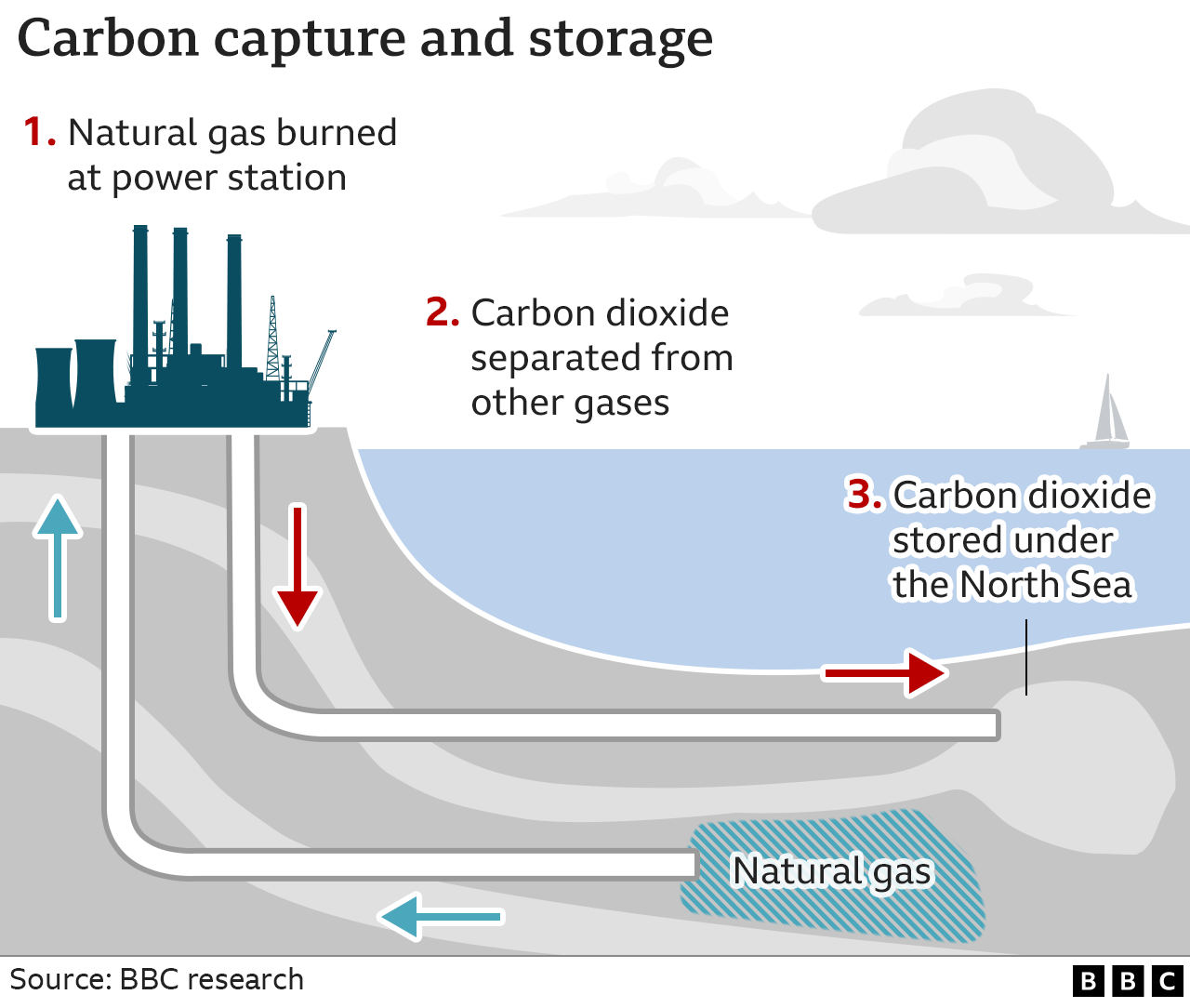Carbon capture and storage infrastructure is designed to prevent carbon dioxide (CO2) from industrial processes and power stations being released into the atmosphere.
Currently, the technology is seen as expensive but it should in theory enable fossil fuels to be used without making global warming worse.
How does carbon capture and storage work?
Burning fossil fuels like oil, gas and coal to generate electricity emits CO2, which is the main driver of climate change.
The carbon capture process stops most of the CO2 produced from being released, and either re-uses it or stores it underground.
The British government says the North Sea is an ideal place to store CO2. It has plenty of old empty oil and gas reservoirs, and also permeable rocks known as saline aquifers.

Why are carbon capture power plants needed?
Carbon capture power plants are part of the government’s commitment to remove carbon from UK electricity production by 2035. It hopes to build at least one by the mid 2020s, although that deadline now looks improbable.
There has been a big expansion in renewable energy in the last decade, in particular the use of offshore wind, but the unresolved question is how to keep the lights on when the wind isn’t blowing.
Carbon capture power stations are seen as part of the solution, along with the increased use of nuclear energy, and other rapidly-evolving technologies such as hydrogen.
What has the government committed to?
In March the government agreed to go ahead with funding three carbon capture facilities near Redcar on Teesside. One will capture carbon from a gas-fired power station and the two others from hydrogen production. All would connect to a pipeline that transports the captured CO2 under the North Sea for storage. Five projects in north west England and North Wales are also in the final stages of development with the CO2 there being stored under the River Mersey.
The government is supporting the development of carbon capture clusters, hubs where different industrial processes can plug into the same CO2 pipes and storage systems. The two most advanced clusters are the East Coast Cluster (Teeside/Humber) and Hynet (North-west England and North Wales).
In July two new clusters Viking (Humber) and Acorn (north east Scotland) were chosen as the UK’s third and fourth carbon capture and storage clusters.
How much CO2 will the carbon capture plants remove?
In 2021, the UK emitted 425m tonnes of CO2. That’s fallen by almost 50% since 1990.
The amount being captured at these proposed power stations is very small by comparison.
None of the proposed carbon capture plants claims to capture more than 2m tonnes a year.
The government has set a target to capture between 20-30m tonnes of CO2 a year by 2030. That could involve other industrial processes as well as power generation.
How much will carbon capture and storage cost?
Capturing the carbon dioxide from industrial processes and then storing it underground requires infrastructure. That means the processes will be more expensive than projects where the CO2 is simply emitted into the atmosphere.
The basic technology has been around for decades. It’s mainly been used in industries where captured CO2 can be reused, for example to force out oil and gas from underground reserves.
There are no such plans to use the CO2 from new power stations.
The cost of a new gas power station, providing electricity for nearly a million homes, is around £350m.
Catherine Raw of energy company SSE told the BBC that building a similar sized gas power station with carbon capture would roughly double the cost.
The hope is that the price might fall over time in same way that the coast of renewable energy has plummeted in the last decade.
There are those who see carbon capture as too expensive and believe the money would be better spent on renewables and power storage (like batteries).
“These power stations look like another excuse for the government to show preference to their friends in the oil and gas industry, making energy more expensive to everyone else’s disadvantage,” says Dr Doug Parr of campaign group Greenpeace UK.
Do other countries have carbon capture?
In September 2022 there were just 30 carbon capture facilities in the world, according to a report from the Global CCS Institute.
Almost all of these are attached to industrial plants carrying out activities such as natural gas processing or fertiliser production.
Once built, it is hoped other industries would use the UK power station’s pipeline to store CO2 under the North Sea.

The only carbon capture power station currently operating is a coal-fired plant at Boundary Dam in western Canada.
However, several carbon capture gas power stations similar to those proposed in the UK are in development, mostly in the US.



